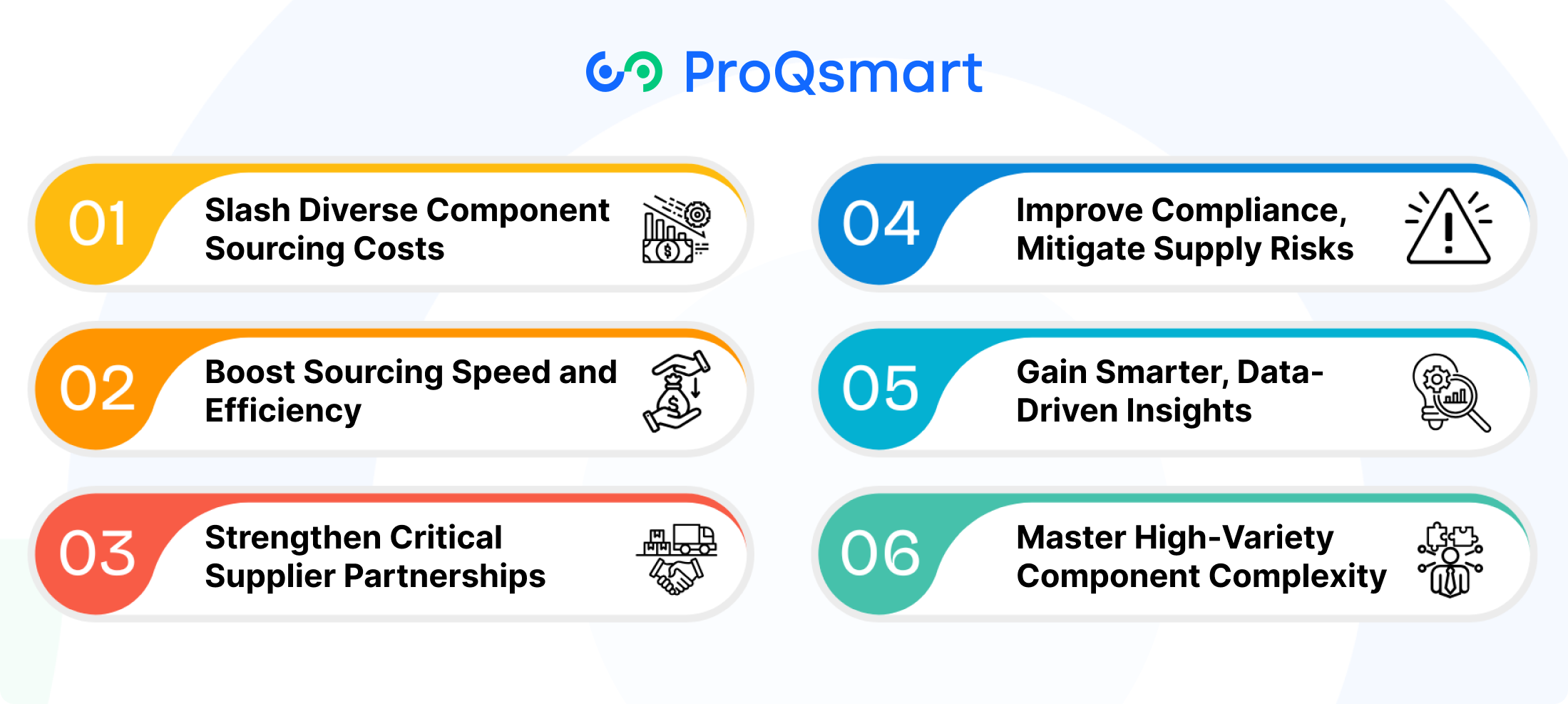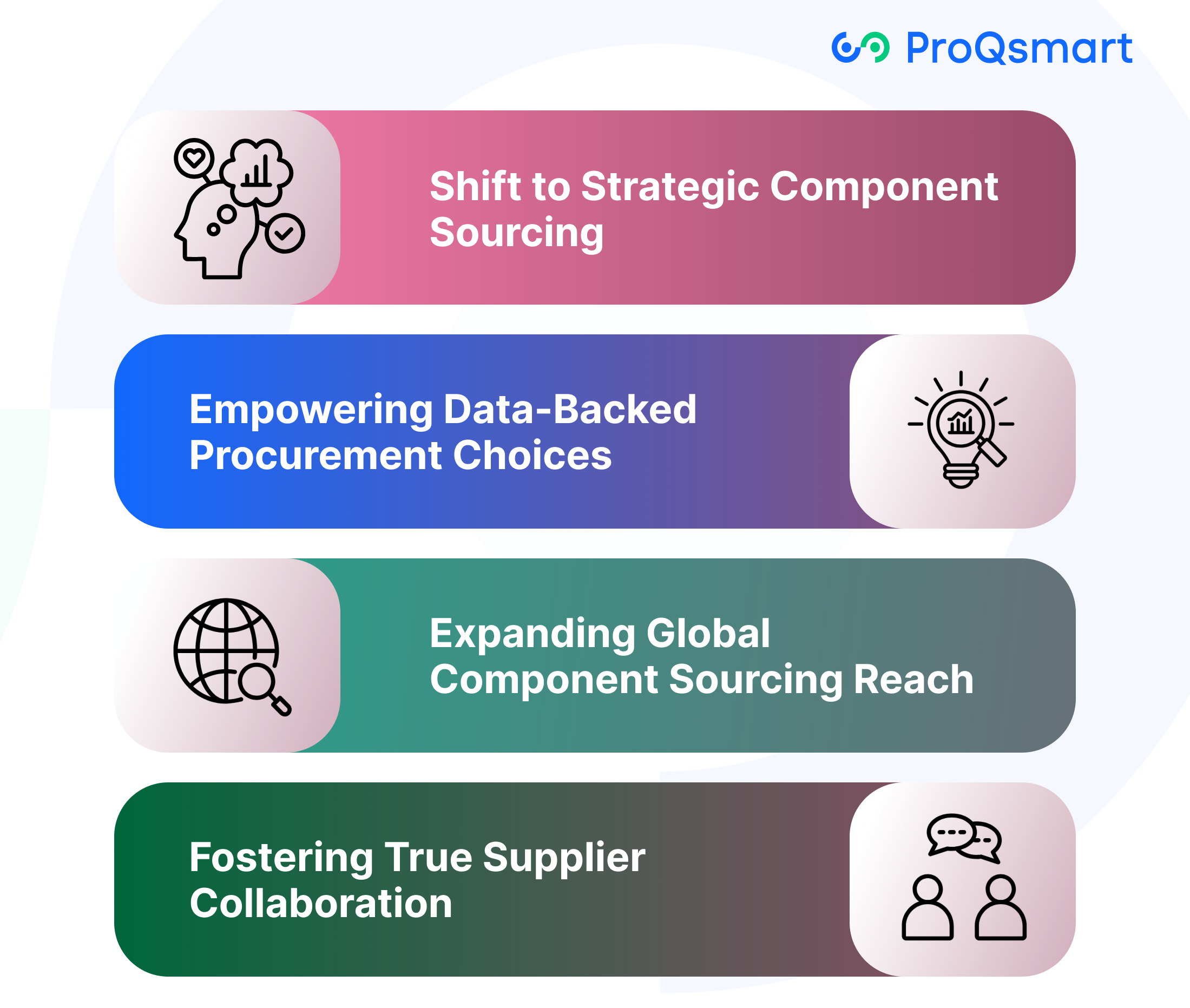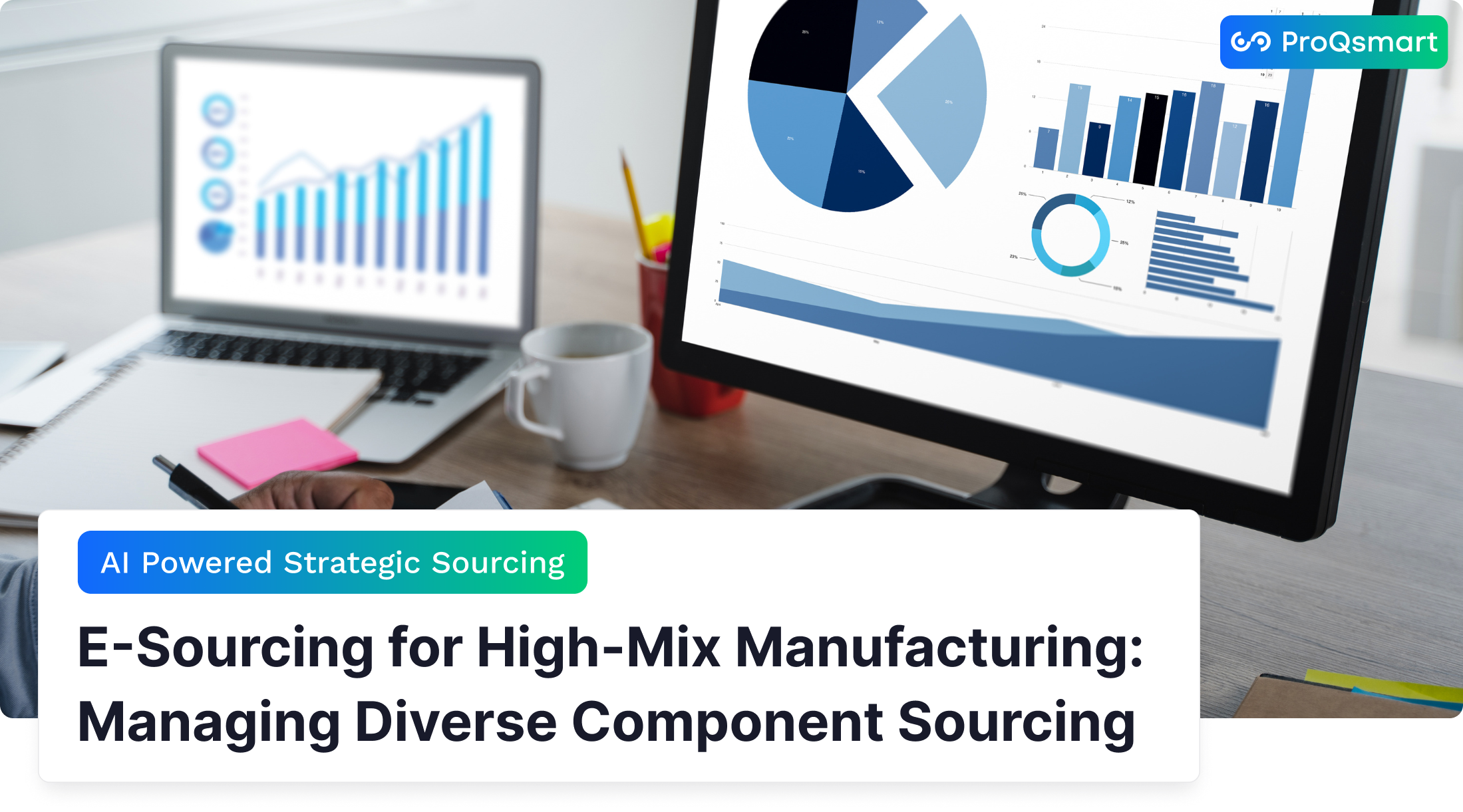E-sourcing revolutionizes component sourcing by enabling teams to efficiently locate, bid on, and procure a diverse range of parts. This digital approach accelerates decision-making, expands supplier options, and reduces lead times, ultimately driving cost savings.
In high-mix manufacturing environments, where managing numerous unique components is critical, e-sourcing platforms provide real-time access to supplier data and market trends. This visibility helps identify pricing fluctuations and quality variations, which is essential for meeting tight project deadlines and maintaining production flow.
Furthermore, e-sourcing supports ongoing supplier performance monitoring and ensures adherence to compliance standards. The following sections explore how e-sourcing integrates into complex component supply chains and offer practical strategies to enhance procurement outcomes.
E-Sourcing: Beyond Simple Digital Purchasing
E-sourcing has redefined procurement by combining advanced strategies, real-time data, and powerful tools to deliver more efficient and transparent sourcing processes. It goes well beyond simple online ordering, enabling organizations to manage complex supplier interactions with greater precision and speed.
Modern e-sourcing platforms allow buyers to issue detailed requests for quotations (RFQs), compare bids instantly, and finalize contracts with ease. Features such as competitive electronic auctions enable suppliers to submit bids in real time, accelerating decision-making and driving significant cost savings—often up to 20% in the first year.
Data analytics play a critical role by providing actionable insights into supplier performance, spending trends, and new opportunities for optimization. Automation reduces human error, speeds up approvals, and streamlines order fulfillment, while collaboration tools foster ongoing communication and alignment between buyers and suppliers.
By leveraging these capabilities, e-sourcing empowers manufacturers to optimize procurement efficiency, control costs, and build stronger, more reliable supplier relationships.
Core Elements for Component Needs
- Supplier management systems and bidding platforms
- Centralized databases for supplier info and history
- Analytics to score and rank supplier performance
- Contract management and compliance tracking
Today, e-sourcing tools connect with IoT and blockchain, enhancing procurement practices by providing tracking, authenticity, and transparent records throughout the supply chain.
Unlock E-Sourcing Wins for Components

E-sourcing has changed the game for teams sourcing components. It does so by creating a competitive advantage through decreasing time, costs, and increasing transparency within the process. For teams that source parts daily—especially those handling custom jobs or high-mix production—these digital tools do more than speed up tasks.
They enable teams to drive more favorable terms, stronger relationships with suppliers, and reduced risk overall.
1. Slash Diverse Component Sourcing Costs
E-sourcing platforms allow buyers to quickly create competitive bids. This brings multiple suppliers into a single process, dramatically increasing competition and lowering cost—often 10–30% just from demand planning and cleaner workflows alone. One major electronics manufacturer used e-sourcing to run simultaneous reverse auctions with more than a dozen suppliers.
In fact, within the first six months they reduced costs by almost 20%. Only by tracking their spend can teams begin to identify trends and negotiate competitive, bulk, or long-term deals. These savings drop directly to profit, allowing teams to reinvest into their lines.
2. Boost Sourcing Speed and Efficiency
Automation enables procurement teams to reduce sourcing cycles from weeks to days. With access to real-time data, teams can make decisions immediately, no more delays waiting on updates or quotes. One such auto supplier, for example, cut their sourcing times in half, allowing their staff to focus on more strategic, deep-dive work.
Best practices:
-
Keep supplier lists updated
-
Use templates for bids
-
Sync data dashboards, and
-
Schedule reviews for each sourcing event
3. Strengthen Critical Supplier Partnerships
Digital sourcing tools can help facilitate this clear sharing of information, track who’s getting the best deals, and maintain open lines of communication. This fosters a spirit of collaboration, ensures you address problems before they escalate, and provides mutual transparency into what is important.
Tracking supplier progress and scheduling weekly or bi-weekly check-in meetings keeps both your teams and supplier partners focused on mutually agreed-upon priorities.
4. Improve Compliance, Mitigate Supply Risks
With digital systems, teams have the ability to audit suppliers, monitor compliance, and identify gaps in real-time. This reduces risk and helps maintain the flow of orders, even during turbulent times. A more diversified supplier base can cut negative economic impact in half.
Key steps: vet vendors, keep records, review contracts, and run supplier checks often.
5. Gain Smarter, Data-Driven Insights
E-sourcing tools enhance visibility into spending patterns, helping procurement teams identify the best suppliers and forecast their sourcing needs effectively. By utilizing these electronic sourcing tools, teams can evaluate how suppliers stack up against one another and improve sourcing practices round after round. Organized data allows buyers to delve deep into supplier records, achieving savings of up to 10–50%.
6. Master High-Variety Component Complexity
High-variety component complexity comes with high-mix production, necessitating the management of multiple suppliers and components. E-sourcing tools offer a streamlined procurement process, allowing teams to categorize suppliers by skill, size, and type. Whether building, modifying, or repairing, teams can monitor sourcing activities and changes seamlessly.
|
Sourcing Method |
Handling Complexity |
Speed |
Savings |
Risk Control |
|
Traditional Sourcing |
Low |
Slow |
Low |
Medium |
|
E-Sourcing |
High |
Fast |
High |
High |
Essential E-Sourcing Platform Capabilities

The right e-sourcing platform serves as the backbone of consistent, dependable component sourcing. To procurement teams, that ideal e-sourcing tool set translates into quicker cycle times, more informed supplier decisions, and demonstrable cost savings.
Operational capabilities determine how teams function on a daily basis, from intuitive, easy-to-use dashboards to advanced analytics and encrypted data security. Those foundational capabilities must make life easier than ever for buyers and suppliers alike. Real value should be apparent at each stage of the sourcing process.
Centralized Supplier Information Hubs
A centralized hub for supplier information reduces the time your team spends hunting down information and prevents confusion. When contact information, compliance history and performance ratings all reside in a centralized location, teams can make informed decisions.
This way, they see a complete picture of every supplier. This configuration lends itself to simplifying the process of keeping information up to date, identifying gaps in the information and strengthening relationships with suppliers.
For effective decision making, this data must be current and comprehensive—imagine contacts, certifications, previous bids, quality history, risk matrix. A checklist for a supplier hub should include: legal name, contact points, business certs, payment terms, performance history, compliance status, and key contracts.
Automated RFx and Bid Analysis
Automated RFI, RFQ, and eAuction processes reduce the sourcing cycle time. Procurement teams are able to establish templates, publish requests to the web, and utilize scoring matrices to evaluate bids in comparison with one another. Using tools such as weighted scoring, it becomes easy to identify best-value bids.
Steps include: Draft RFx, set criteria, post online, track responses, run auto-scoring, and rank bids.
Automated bid review functionality saves hours of time and makes the process more equitable.
Real-Time Component Price Visibility
Having access to real-time pricing and availability allows procurement professionals to identify cost savings opportunities and adjust bidding strategies in a timely manner. In an industry where price and availability data can fluctuate by the hour, real-time price feeds help ensure that teams are purchasing intelligently and avoiding overpaying.
Market trend visibility allows you to watch the market and time purchases or lock in contracts. For those focused on budget control, this visibility translates into fewer surprises and greater spend under management.
Seamless ERP/SCM System Integration
Integrating e-sourcing platforms with ERP or SCM systems ensures data between them always matches up. This connection eliminates the need for double entry and reduces mistakes.
It allows project teams to reconcile purchase orders, invoices, and contracts between departments. For smooth rollout, focus on key integration points: supplier master data, order flow, contract management, spend reports, and approval chains.
Robust Analytics for Better Decisions
Analytics tools allow teams to visualize what’s successful and what needs to be adjusted. Concise dashboards and reports for supplier cost, on-time delivery rates, savings, etc., help identify trends quickly.
This enables us to identify even greater opportunities for savings. By continuously analyzing sourcing data, organizations can all stay sharper in the process and uncover additional opportunities to reduce costs or increase quality.
ProQsmart, for instance, provides AI-driven analytics and budget tracking in real-time. Their robust analytics suite provides more accurate, streamlined reporting for better decision-making.
Implement E-Sourcing: A Practical Guide
E-sourcing is revolutionizing how teams discover, procure, and oversee components. The good news is that there are tons of tools on the market! Selecting and implementing the proper e-sourcing platform can seem like an intimidating task.
Right out of the gate, align your e-sourcing implementation with larger purchasing objectives. Focus on achieving cost savings, getting the best suppliers selection and saving time on your processes! When configured properly, an e-sourcing solution streamlines supply chains. It integrates easily with ERP and BI tools, so teams can spend less time in tedious, manual check-in meetings.
Choose Your Ideal E-Sourcing Solution
Look for solutions that expand as your business expands and evolves to suit your future needs. Choose something with a straightforward, intuitive dashboard that anyone can pick up and be comfortable with immediately.
Some must-haves:
-
Supplier self-registration,
-
Real-time alerts,
-
Strong data protection, and
-
Links to your other work systems.
Be sure to test out the software’s capabilities in supporting high user volume or large-scale projects. Additionally, check to see if it facilitates both easy and complex purchasing.
Streamline Existing Sourcing Workflows
Start by understanding your current practice. Identify bottlenecks or time-consuming tasks. E-sourcing automates repetitive tasks, which allows your team to focus on value-added work.
It allows teams to identify areas of growth, so regularly review and adjust your processes to get the most out of e-sourcing.
Enable and Onboard Your Suppliers
Include suppliers early, provide clear instructions, and train them. Follow up with assistance, to keep them invested.
Best practices: share how-to videos, set up live help, keep feedback lines open, and check in on progress.
Drive Adoption Through Change Management
Change is always more successful when backed by solid leadership. Gain advocates by demonstrating benefits and addressing team objections.
Steps: set goals, train users, track progress, and keep talking about wins and lessons.
Measure Performance, Continuously Improve
Create realistic goals (KPIs) to measure from the beginning of your procurement strategy. Revisit outcomes regularly, address challenges that aren’t working in your e sourcing initiatives, and showcase successes.
Overcome Common E-Sourcing Hurdles

Sourcing components via e-sourcing offers tangible benefits. Along with those opportunities, it poses challenges that can drag teams down if they’re not confronted directly. Common issues typically arise when it comes to initial configuration, data integration and management, and supplier onboarding.
Understanding these common barriers ahead of time will allow procurement teams to better equip themselves to realize the full potential of e-sourcing tools.
Navigating Initial Setup Challenges
Every team encounters roadblocks during the initial stages. Launching an e-sourcing platform requires getting all stakeholders aligned on the end goal.
Clear requirements, good planning, and getting the right people involved early on—essentially people from engineering, finance, and procurement—are crucial. Training is essential—not only for the tech itself, but for new workflows and policies being established. A realistic checklist might consist of things like mapping out existing workflows, compiling lists of suppliers, establishing user roles, and conducting test bids.
Ensuring High-Quality Data Integrity
Quality data is the foundation of e-sourcing. When data is outdated or incorrect, the result is less competitive bids and delayed award decisions.
Frequent audits, stringent guidelines for data entry, and robust data governance safeguard supplier information and prevent mistakes. It’s important that teams establish a regular schedule for data verification and maintain updated contact lists and price sheets at all times.
Tools that centralize all data prevent project sprawl and provide all parties a single source of truth, reducing ambiguity.
Managing Diverse Supplier Tech Levels
Each supplier will come in at a different level in terms of tech savviness. Some are able to log in without issue while others struggle to figure it out or require assistance.
To help overcome this hurdle, procurement teams should provide supplier-friendly training and easy-to-follow documentation. Testing supplier readiness prior to a large-scale rollout will help you avoid surprises down the line.
Centralizing all vendor communication helps align everyone and reduces unexpected hold-ups. E-sourcing tools speed up cycle times and keep rogue spending at bay.
E-Sourcing’s Transformative Procurement Impact
E-sourcing is revolutionizing the way manufacturing teams procure new parts and components. By taking procurement online, it accelerates the buying process, reduces administrative burden, and enables teams to truly focus on outcome. Teams are now able to quickly bring up RFQs, compare supplier bids and seal deals in hours rather than weeks.
It serves to store documentation in one place, allowing for easy audit and reducing compliance liability.
Shift to Strategic Component Sourcing
Now, with e-sourcing, supply managers can go from the reactive mode of chasing quotes to the proactive mode of developing robust sourcing strategies. Today, teams strategically use data-driven criteria to select partners that best address business and operational objectives rather than simply selecting the lowest possible priced option.
Accommodating proactive supplier engagement—whether to shape initial requirements or jointly establish quality control standards—yields a far better fit and many fewer surprises. This shift makes sure sourcing lines up with what matters most: cost, quality, and lead times.
|
Benefits |
Strategic Sourcing |
Traditional Sourcing |
|
Supplier fit |
High |
Low |
|
Data for decisions |
Robust |
Limited |
|
Speed and transparency |
Fast, open |
Slow, opaque |
|
Cost control |
Strong |
Weak |
Empowering Data-Backed Procurement Choices
E-sourcing empowers teams to make data backed procurement decisions. Procurement teams can identify pricing trends, review historical supplier performance, and evaluate contract terms side by side.
Empowering data-backed procurement choices analytics illuminate areas of risk and potential savings. Equipped with this knowledge, it becomes more manageable, more effective and more strategic to negotiate with suppliers.
ProQsmart, for instance, employs AI to identify cost-saving opportunities and streamline workflows automatically. It monitors budgets and supplier performance scores, so teams are always optimizing their sourcing.
Expanding Global Component Sourcing Reach
Increased access to global suppliers E-sourcing increases teams’ access to global suppliers, allowing them to source rare or custom parts from a wider array of suppliers. These platforms make it easy for them to find qualified vendors, manage e-tenders, and conduct the entire process—including all paperwork—online.
Knowing global trends—such as the recent tariffs or raw material shifts—leads to smarter purchases. Teams must verify vendor credentials, determine the best logistics approach, and monitor currency fluctuations.
Fostering True Supplier Collaboration
E-sourcing promotes collaboration with suppliers. Shared platforms enable open chat, collaborative problem solving and real-time updates.
This not only builds supplier trust but encourages open feedback that enables problems to be resolved quickly. Robust supplier relationships result in superior quality, reduced costs, and increased timeliness.
Conclusion
E-sourcing introduces innovative tools and streamlined methods for locating and purchasing components efficiently. Teams gain real-time visibility into quotes, quickly identify bottlenecks, and keep procurement processes on track. This not only reduces waste and saves costs but also builds trust through reliable, consistent supplier relationships. By eliminating delays caused by lost documents and unreturned communications, e-sourcing simplifies the sourcing journey—allowing users to search, compare, and select suppliers in just a few clicks. Platforms featuring intuitive dashboards, comprehensive audit trails, and transparent pricing empower both buyers and suppliers to operate with clarity and confidence. For organizations seeking to reduce frustration and improve procurement success, adopting e-sourcing is a strategic step forward. To explore how ProQsmart can enhance your sourcing process, schedule a demo today.




